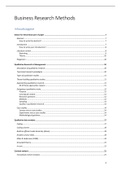Summary
Summary Business Research methods Master Business Administration
- Course
- Institution
Full summary of all classes Business Research Methods given by prof Martine Cools and prof Kathleen Cleeren in academic year . Passed during first examination period.
[Show more]



